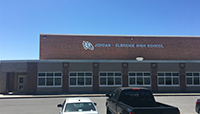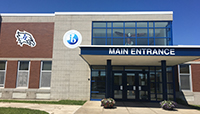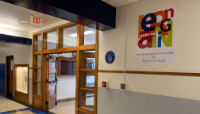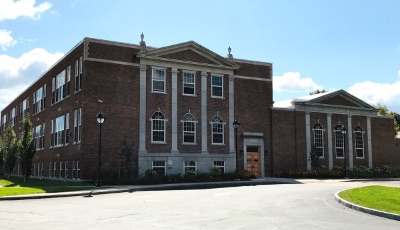District Special Education Plan
Special Education Plan. Last updated 8.18NYSED REGULATIONS AND DEFINITIONS
- Special education means specially designed individualized or group instruction or special services or programs and special transportation, provided at no cost to the parent, to meet the unique needs of students with disabilities. Such instruction includes but is not limited to that conducted in classrooms, homes, hospitals, institutions and in other settings.
- Specially designed instruction means adapting, as appropriate to the needs of an eligible student, the content, methodology, or delivery of instruction to address the unique needs that result from the student's disability; and to ensure access of the student to the general curriculum, so that he or she can meet the educational standards that apply to all students.
- Special education services for school-age students with disabilities are to be offered on a continuum so as to best meet an individual student's needs.
- The district must include, in its continuum of placement options, interim alternative educational settings (IAES) options for students with disabilities who have been suspended or removed from their current placement for more than 10 school days pursuant to Part 201 of the Regulations of the Commissioner of Education. The IAES, to the extent provided in Part 201, must be an educational setting other than the student's current placement at the time the behavior precipitating the IAES placement occurred. The district’s tutoring center serves as an IAES on as needed basis.
- A student placed in an IAES must:
- Continue to receive educational services so as to enable the student to continue to participate in the general education curriculum, although in another setting and to progress toward the goals set out in the student's IEP.
- Receive, as appropriate, a functional behavioral assessment and behavioral intervention services and modifications that are designed to address the behavior violation so that it does not reoccur.
- Receive, as appropriate, a functional behavioral assessment and behavioral intervention services and modifications that are designed to address the behavior violation so that it does not reoccur.
- The district affords a continuum of services including:
-Consultant teacher services are defined as direct and/or indirect services provided to a schoolage student with a disability in the student's general education classes, including career and technical education classes, and/or to such student’s general education teachers.
-Direct consultant teacher services are specially designed instruction provided to an individual student with a disability or to a group of students with disabilities by a certified special education teacher to aid the student(s) to benefit from the general education class instruction.
- Indirect CT services are a consultation provided by a certified special education teacher to a general education teacher to assist the general education teacher in adjusting the learning environment and/or modifying his/her instructional methods to meet the individual needs of a student with a disability who attends the general education class.
- Indirect CT services are a consultation provided by a certified special education teacher to a general education teacher to assist the general education teacher in adjusting the learning environment and/or modifying his/her instructional methods to meet the individual needs of a student with a disability who attends the general education class.
Notes:
o Direct consultant teacher is sometimes combined with indirect consultant services.
o The district meets or exceeds the minimum number of 2 hours per week for direct and/or
indirect consultant teacher services.
o Direct consultant teacher is sometimes combined with indirect consultant services.
o The district meets or exceeds the minimum number of 2 hours per week for direct and/or
indirect consultant teacher services.
- Resource room is a special education program for a student with a disability enrolled in either a special class or general education class who is in need of specialized supplementary instruction in an individual or small group setting for a portion of the school day.
Notes:
o The district meets or exceeds the minimum number of 3 hours per week for resource room services without surpassing the 50% ceiling.
o The district does not exceed the resource room instructional group size capped at 5 students per teacher.
o The district does not assign a teacher providing K-6 resource room services a caseload over 20 students nor does it assign a teacher providing 7-12 resource room services a caseload over 25 students.
o The district meets or exceeds the minimum number of 3 hours per week for resource room services without surpassing the 50% ceiling.
o The district does not exceed the resource room instructional group size capped at 5 students per teacher.
o The district does not assign a teacher providing K-6 resource room services a caseload over 20 students nor does it assign a teacher providing 7-12 resource room services a caseload over 25 students.
- Integrated Co-teaching services are the provision of specially designed instruction and academic instruction provided to a group of students with disabilities and non-disabled students. The district does not exceed the maximum number of 12 students with disabilities on the roster of a class where integrated co-teaching services are provided. In this model, a general education teacher and a special education teacher share responsibility for the delivery of primary instruction, planning and evaluation for all students.
- Special Class is the provision of specially designed instruction in a self-contained setting, meaning that such students are receiving their primary instruction separate from their nondisabled peers.
OTHER SERVICES
- In addition to special education programs on the continuum, other services may be recommended for students including:
- Transition services are a coordinated set of activities for a student with a disability beginning not later than the first individualized education program (IEP) to be in effect when the student is age 15 (and at a younger age, if determined appropriate), designed within a results-oriented process that is focused on improving the academic and functional achievement of the student with a disability to facilitate the student's movement from school to post-school activities.
- Transitional support services are those temporary services, specified in a student's IEP, provided to a general or special education teacher to aid in the provision of appropriate services to a student with a disability transferring to a general education classroom or to another special education program or service in a less restrictive environment.
- Travel training is instruction, as appropriate, provided to students with significant cognitive disabilities, and any other students with disabilities who require this instruction, to enable them to develop an awareness of the environment in which they live; and learn the skills to move effectively and safely from place to place within that environment (e.g., in school, in the home, at work, and in the community).
- Adapted PE is a specially designed program of developmental activities, games, sports and rhythms suited to the interests, capacities and limitations of students with disabilities who may not safely or successfully engage in unrestricted participation in the activities of the regular physical education program.
- Twelve-month (ESY) special service and/or program Is a special education service and/or program provided on a year-round basis for students with disabilities determined to require a structured learning environment of up to 12 months duration to prevent substantial regression.
- Special transportation means services and supports necessary for the student to travel to and from school and between schools; in and around school buildings; and includes specialized equipment (such as special or adapted buses, lifts, and ramps), if required to provide special transportation to a student with a disability.
- Transitional support services are those temporary services, specified in a student's IEP, provided to a general or special education teacher to aid in the provision of appropriate services to a student with a disability transferring to a general education classroom or to another special education program or service in a less restrictive environment.
- Travel training is instruction, as appropriate, provided to students with significant cognitive disabilities, and any other students with disabilities who require this instruction, to enable them to develop an awareness of the environment in which they live; and learn the skills to move effectively and safely from place to place within that environment (e.g., in school, in the home, at work, and in the community).
- Adapted PE is a specially designed program of developmental activities, games, sports and rhythms suited to the interests, capacities and limitations of students with disabilities who may not safely or successfully engage in unrestricted participation in the activities of the regular physical education program.
- Twelve-month (ESY) special service and/or program Is a special education service and/or program provided on a year-round basis for students with disabilities determined to require a structured learning environment of up to 12 months duration to prevent substantial regression.
- Special transportation means services and supports necessary for the student to travel to and from school and between schools; in and around school buildings; and includes specialized equipment (such as special or adapted buses, lifts, and ramps), if required to provide special transportation to a student with a disability.
- Students with disabilities placed together for purposes of special education must be grouped by similarity of individual needs in accordance with the 4 areas listed below:
Academic achievement, functional performance and learning characteristics
- Academic achievement, functional performance and learning characteristics are the levels of knowledge and development in subject and skill areas, including activities of daily living, level of intellectual functioning, adaptive behavior, expected rate of progress in acquiring skills and information, and learning style.
- The range of academic or educational achievement of such students must be limited to assure that instruction provides each student appropriate opportunities to achieve his or her annual goals. For students placed in a special class, except for a 12:1+ (3:1) special class, where the range of achievement levels in reading and mathematics exceeds three years, special notification to the CSE and parents must be provided. The learning characteristics of students in the group must be sufficiently similar to assure that this range of academic or educational achievement is at least maintained.
- The range of academic or educational achievement of such students must be limited to assure that instruction provides each student appropriate opportunities to achieve his or her annual goals. For students placed in a special class, except for a 12:1+ (3:1) special class, where the range of achievement levels in reading and mathematics exceeds three years, special notification to the CSE and parents must be provided. The learning characteristics of students in the group must be sufficiently similar to assure that this range of academic or educational achievement is at least maintained.
Social development
- Social development is the degree and quality of the student's relationships with peers and adults, feelings about self, and social adjustment to school and community environments.
- The social development of each student must be considered prior to placement in any instructional group to assure that the social interaction within the group is beneficial to each student, contributes to each student's social growth and maturity, and does not consistently interfere with the instruction being provided. The social needs of a student cannot be the sole determinant of such placement.
- Social development is the degree and quality of the student's relationships with peers and adults, feelings about self, and social adjustment to school and community environments.
- The social development of each student must be considered prior to placement in any instructional group to assure that the social interaction within the group is beneficial to each student, contributes to each student's social growth and maturity, and does not consistently interfere with the instruction being provided. The social needs of a student cannot be the sole determinant of such placement.
Physical development
- Physical development is the degree or quality of the student's motor and sensory development, health, vitality, and physical skills or limitations which pertain to the learning process.
- The levels of physical development of such students may vary, provided that each student is given appropriate opportunities to benefit from such instruction. Physical needs must be considered prior to determining placement to assure access to appropriate programs. The physical needs of the student cannot be the sole basis for determining placement.
- Physical development is the degree or quality of the student's motor and sensory development, health, vitality, and physical skills or limitations which pertain to the learning process.
- The levels of physical development of such students may vary, provided that each student is given appropriate opportunities to benefit from such instruction. Physical needs must be considered prior to determining placement to assure access to appropriate programs. The physical needs of the student cannot be the sole basis for determining placement.
Management needs
- Management needs are the degree to which environmental modifications and human or material resources are required to enable the student to benefit from instruction.
- Management needs must be determined in accordance with the factors identified for a student in relation to the areas of academic achievement, functional performance and learning characteristics, social development and physical development. The environmental modifications or adaptations and the human or material resources provided may not consistently detract from the opportunities of other students in the group to benefit from instruction.
- Supplementary aids and services means aids, services and other supports to enable students with disabilities to be educated with nondisabled students to the maximum extent appropriate in the least restrictive environment.
-Accommodations are adjustments to the environment, instruction or materials that allow a student with a disability to access the content or complete assigned tasks. Accommodations do not alter what is being taught.
- Program modifications may be used to describe a change in the curriculum or measurement of learning, for example, when a student with a disability is unable to comprehend all of the content an instructor is teaching (e.g., reduced number of assignments; alternate grading system).
- Supplementary aids and services, accommodations and/or program modifications can be provided in general education classes, special classes or other education-related settings, including extracurricular and non-academic settings.
- Management needs are the degree to which environmental modifications and human or material resources are required to enable the student to benefit from instruction.
- Management needs must be determined in accordance with the factors identified for a student in relation to the areas of academic achievement, functional performance and learning characteristics, social development and physical development. The environmental modifications or adaptations and the human or material resources provided may not consistently detract from the opportunities of other students in the group to benefit from instruction.
- Supplementary aids and services means aids, services and other supports to enable students with disabilities to be educated with nondisabled students to the maximum extent appropriate in the least restrictive environment.
-Accommodations are adjustments to the environment, instruction or materials that allow a student with a disability to access the content or complete assigned tasks. Accommodations do not alter what is being taught.
- Program modifications may be used to describe a change in the curriculum or measurement of learning, for example, when a student with a disability is unable to comprehend all of the content an instructor is teaching (e.g., reduced number of assignments; alternate grading system).
- Supplementary aids and services, accommodations and/or program modifications can be provided in general education classes, special classes or other education-related settings, including extracurricular and non-academic settings.
DISTRICT ASSURANCES
BOE Policy 7410; 7620
- Students with disabilities residing in the district have the opportunity to participate in school district programs.
BOE Policy 7631; 7632; 1330
- Qualified personnel, including the members and chairpersons of the Committee on Preschool Education and the Committee on Special Education, will be appointed and training will be provided as needed.
BOE Policy 7611; 7616; 7617
- Special services and programs are provided, to the extent appropriate, to enable the student to participate and progress in the general education curriculum.
BOE Policy 7660
- Parents receive procedural safeguards as part of the request for consent to evaluate mailing.
BOE Policy 7640
-The confidentiality of personally identifiable data and records of students with disabilities is
protected.
protected.
BOE Policy 7618
-The Committee on Preschool Education and the Committee on Special Education adhere to regulations specific to the declassification of students.
BOE Policy 7690
- The district has a process for the selection and appointment of an impartial hearing officer.
BOE Policy 6210
- The district has identified steps it shall take to recruit, hire, train, and retain highly qualified personnel.
BOE Policy 8130
- The district has a process to provide all instructional materials in usable alternative formats for each student with a disability in accordance with said student’s needs.
IN-DISTRICT PROGRAMMING
- The district does not exceed the 15:1 special class size for students whose primary need is specialized instruction delivered in a self-contained setting. The district offers 15:1 math, 15:1 ELA special class programing.
- The district offers a 12:1:1 self-contained classroom at the primary, intermediate and middle school levels.
Note:
o The District does not exceed the chronological age range of 36 months within special classes of students with disabilities.
- The District contracts with CO BOCES to provide programing to high school students whose management needs interfere with the instructional process in a class size not to exceed 12:1:1.
- The District contracts with CO BOCES to provide programing to students whose management needs are intensive in a class size not to exceed 8:1:1.
- The District contracts with CO BOCES to provide programing to students whose management needs are highly intensive in a class size not to exceed 6:1:1. (Day Treatment)
- The District contracts with CO BOCES to provide programing to autistic students whose management and educational needs are highly intensive in a class size not to exceed 6:1:1.
- The District contracts with OCM BOCES to provide programing to deaf and hard of hearing students.
- Related services are those that assist a student in benefiting from other special education services or assist the student in accessing the general curriculum.
- Related services include, but are not limited to speech-language pathology, audiology services, interpreting services, psychological services, physical therapy, occupational therapy, counseling services, orientation and mobility services, school nurse services, school social work, and assistive technology services.
- The District contracts with Lifespan for occupational and physical therapies.
- The District contracts with Citi BOCES to provide audiological services.
- The District contracts with OCM BOCES for the orientation and mobility services as well as the services of a teacher of the visually impaired.
Note:
o When a related service is provided to a number of students at the same time, the District does not exceed the ceiling of 5 students.
- The District’s special education support staff is comprised of a cadre of teaching assistants. The District’s teaching assistants are under the general supervision of a special education teacher.
- The duties of a teaching assistant include but are not limited to:
- Working with individual students or groups of students on special instructional projects
- Providing the teacher with information about students which will assist the teacher in the development of appropriate learning and behavioral experiences
- Assisting students in the use of available instructional resources and development of instructional materials
- Assisting in the development of instructional materials
- Assisting in providing testing accommodations
- Utilizing their own special skills and abilities by assisting in instructional programs in such areas as: foreign languages, arts, crafts, music and similar subjects
- Assisting in related instructional work as required
- Assisting students with specific health related activities as appropriate
- Providing the teacher with information about students which will assist the teacher in the development of appropriate learning and behavioral experiences
- Assisting students in the use of available instructional resources and development of instructional materials
- Assisting in the development of instructional materials
- Assisting in providing testing accommodations
- Utilizing their own special skills and abilities by assisting in instructional programs in such areas as: foreign languages, arts, crafts, music and similar subjects
- Assisting in related instructional work as required
- Assisting students with specific health related activities as appropriate
EVALUATION
- The evaluation of special education services will be based on student graduation and achievement data contained in the NYS report card.
BUDGET
- The District’s general fund and allocations form federal grants, IDEA 611 and IDEA 619, support the provision of special education services.
- Per BOE policy allocation of space within the district will be accommodated.The special programs office provides student numbers and space needs as part of the budget process on an annual basis.
- Student count by age and disability:(Note:Data is as of 8.3.18.)
| Disability Classification | Age | # | Total |
|
Speech and Language Impaired
|
5-10 | 17 | 21 |
| 11-13 | 4 | ||
| 14+ | 0 | ||
|
Learning Disabled
|
5-10 | 9 | 77 |
| 11-13 | 30 | ||
| 14+ | 38 | ||
|
Other Health Impaired
|
5-10 | 2 | 20 |
| 11-13 | 0 | ||
| 14+ | 18 | ||
|
Autistic
|
5-10 | 3 | 14 |
| 11-13 | 6 | ||
| 14+ | 5 | ||
|
Emotionally Disturbed
|
5-10 | 5 | 10 |
| 11-13 | 3 | ||
| 14+ | 2 | ||
|
Multiply Disabled
|
5-10 | 2 | 7 |
| 11-13 | 2 | ||
| 14+ | 3 | ||
|
Traumatic Brain Injury
|
5-10 | 0 | 2 |
| 11-13 | 0 | ||
| 14+ | 2 | ||
| |
|||
| Disability Classification | Age | # | Total |
|
Hearing Impaired
|
5-10 | 1 | 1 |
| 11-13 | 0 | ||
| 14+ | 0 | ||
|
Intellectually Deficient
|
5-10 | 2 | 7 |
| 11-13 | 4 | ||
| 14+ | 1 | ||
|
Orthopedically Impaired
|
5-10 | 1 | 0 |
| 11-13 | 0 | ||
| 14+ | 0 | ||
|
Deaf and Hard of Hearing
|
5-10 | 0 | 1 |
| 11-13 | 1 | ||
| 14+ | 0 | ||
- Student count by program enrollment. (Note:Data is as of 8.3.18.)
| Program | Total |
| Consultant Teacher | 9 |
| Resource Room | 120 |
| 15:1 | 41 |
| 12:1:1 | 29 |
| 8:1:1 | 4 |
| 6:1:1 | 3 |
| 6:1:1 Residential | 1 |
Downloads




